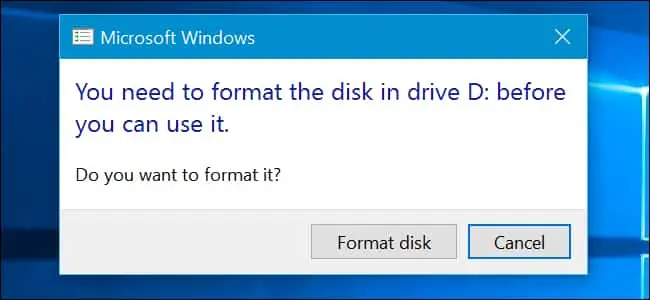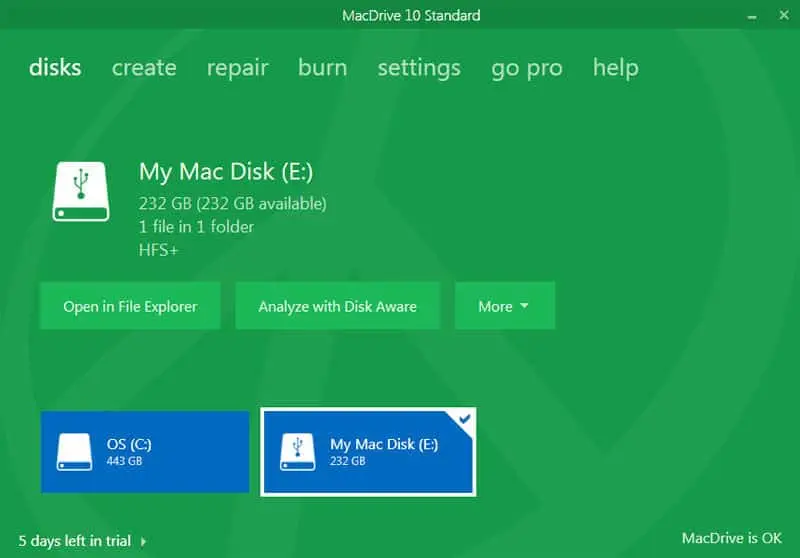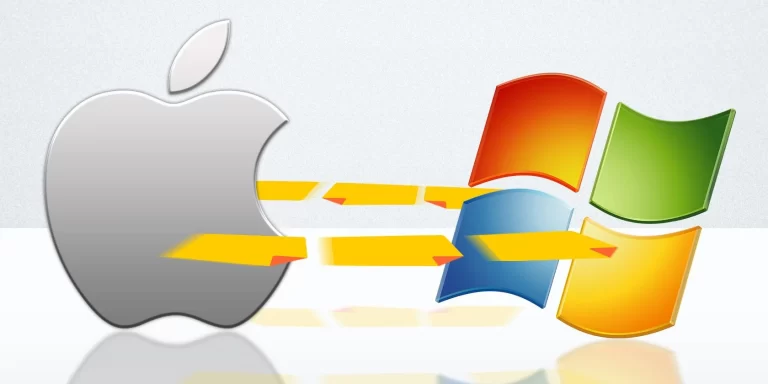Because Windows is unable to read Mac-formatted drives, it will offer to wipe them. Third-party applications, on the other hand, bridge the gap and provide Windows users access to disks formatted with Apple’s HFS+ file system. You may also recover Time Machine backups for Windows using this method.
If you plan on using a drive on both Windows and Mac, you must use the exFAT file system, which really is cross-platform. However, if you weren’t expecting it, you might have formatted your disc using Apple’s HFS Plus, which Windows can’t read by default. Some manufacturers even sell pre-formatted “Mac” drives with this Mac-only file system.
What you will see here?
Please don’t format the hard drive!

If you link a Mac-formatted disc to Windows, you’ll be told that “before you can use it, you must format the disc in drive X:.” If you click “Format disc,” Windows will wipe the contents of the drive; instead, select “Cancel.”
Because Windows can not recognize Apple’s HFS+ file system, this message occurs. That’s great; other applications do as well. Just don’t format the drive until you’ve removed all of the crucial files.
Of course, if the disc is empty and contains no vital files, you can format it. But make certain there’s nothing further you require before proceeding.
HFSExplorer Is Free and Basic

HFSExplorer is a good choice if you only have to get a few files off the device. It’s the only way of accessing a Mac-formatted drive that’s absolutely free. It does, however, require Java, which you must first install. Then, just like any other Windows program, install HFSExplorer.
HFSExplorer, on the other hand, isn’t flashy and lacks a lot of functionality. It won’t let you write to Mac-formatted drives, so it won’t install a File Explorer-compatible file system driver. You may, however, use HFSExplorer to read a Mac-formatted drive & copy the files to your Windows PC for free. It can also install Mac.dmg disc images in order to access the files contained within them.
The read-only nature of this program isn’t always a bad thing. It assures that no third-party driver issue can harm your Mac-formatted drive or the files on it. Other applications can also be put to read-only mode, but there’s less reason to pay for them if you’re not going to utilize their write support.
Attach your Mac-formatted drive on your Windows PC and run HFSExplorer to get started. Select “Load File System From Device” from the “File” menu. It will detect the linked drive and allow you to load it. The contents of the HFS+ drive will be displayed in the graphical interface. Simply choose the files or folders you want to extract, then click “Extract” and select a destination folder. They’ll be saved in the location you specify on your computer.
Paragon HFS+ is $20, it provides write access and improved integration

The HFS+ for Windows from Paragon is a little fancier, but it comes at a price. This tool installs a file system driver that lets you access a Mac-formatted drive with File Explorer or another Windows application that has an open or save dialogue. It advertises speedier performance, and we wouldn’t be shocked if it outperformed HFSExplorer. It also provides complete read/write access to Mac-formatted discs, unlike HFSExplorer, allowing you to write to them from within Windows. Simply install it, then Mac drives will appear in the same way as any other drive.
If you frequently work with Mac-formatted discs and desire operating system integration, performance, plus write access, Paragon HFS+ is a terrific alternative that will pay off for you. However, if you just need to access files from a Mac-formatted drive on a regular basis, this is overkill, so you can save $20 by sticking with HFSExplorer.
HFS+ for Windows is available for a 10-day free trial from Paragon, so you can see if it’s right for you. You can also utilize the trial and also do with the application by the time. It expires if you only need to get things off of a Mac-formatted drive once.
Mediafour Mac-formatted drives Cost $50 to $70 But Includes More Features

Similar to Paragon’s HFS+ for Windows, Mediafour’s MacDrive has greater functionality and polish. It’s also significantly more expensive than Paragon HFS+, with the Standard version costing $50 and the Pro version costing $70.
For the most part, this software will not be worthwhile. It does, however, have a few distinguishing characteristics, such as support for Mac-formatted RAID devices. It also has a graphical user interface that allows you to verify, repair, and format Mac-formatted devices. HFS+ from Paragon stays out of the way and doesn’t have a graphical interface; it just allows you to access HFS+ volumes in File Explorer and other applications.
If you require all of these features, go ahead and purchase it–it is the most comprehensive solution for working using Mac-formatted drives under Windows. However, you are unlikely to require all of these tools.
MacDrive, both the Standard and Pro versions, are available for a 5-day free trial from Mediafour, so you can evaluate if the extra features are worth it for you.
Format the disk as exFAT–But Be Warned: Your Data Will Be Erased!

You’ll probably like to format the Mac-formatted drive with the exFAT file system once you get all of the data off of it. With no additional third-party software, both Windows and Mac OS X offer the full read-write capability for exFAT discs. FAT32 has certain major limitations–for example, individual files can be 4GB in size–but exFAT does not.
Instead of using a Mac-formatted drive, get the vital files off of it and transfer data between Macs and PCs using exFAT-formatted devices.
In Windows, right-click the drive in the File Explorer window and to choose “Format.” Click “Start” after selecting the “exFAT” file system from the list. Keep in mind that this will delete all of the files upon that drive! Make sure you’ve removed all of your files from the drive or that you’ve chosen the correct drive to format!
When you finish, the drive should work fine on both Windows and Mac computers.
By the way, this method works for both Mac and Windows users–Macs can’t write to a Windows NTFS file system natively, but they can read files from NTFS devices. So, regardless of your main platform, exFAT is most likely the way to go.
Mac-formatted drives: Conclusion
In general, Macs & PCs get along swimmingly. Most file types are compatible with both platforms, and they can communicate across a network.
However, if you have a Mac portable hard drive, sharing it with a Windows device can be difficult because it’s likely to be utilizing Apple’s HFS+ or the newest APFS file system, which neither Windows supports natively.
In OS X Leopard, Apple added NTFS support, allowing you to effortlessly share a Windows disc with your Mac. And it’s possible that your portable drive format in exFAT, which both operating systems could read. However, it is unlikely to do so.
Read more:
- Google Drive for G Suite- A robust cloud storage for all!
- Secure your data efficiently with the Best backup software for windows in 2025!
- Customize and use the Touch Bar with the Notes app on the MacBook Pro!
- How to draw or write on PDF?
- How to Wipe a Hard Drive or SSD: Format a PC Drive to Erase All Data?
















